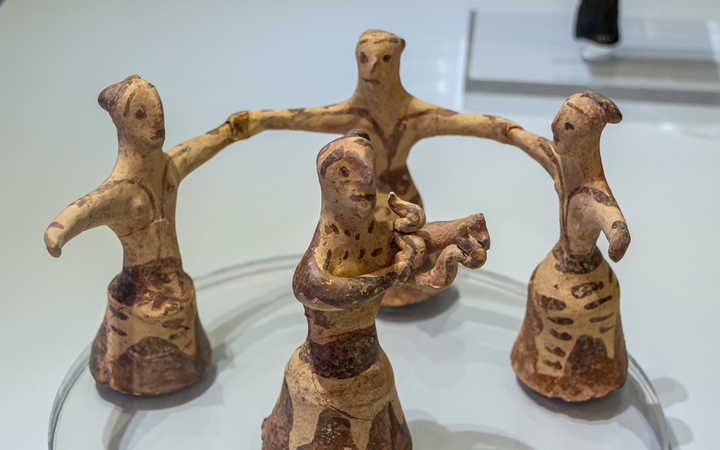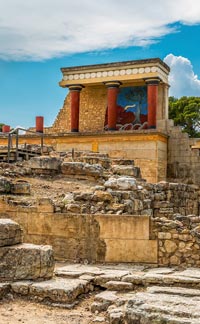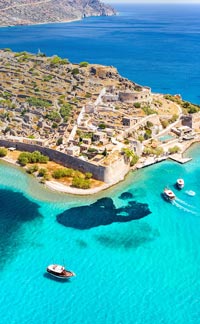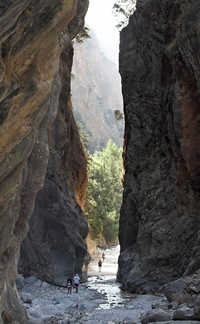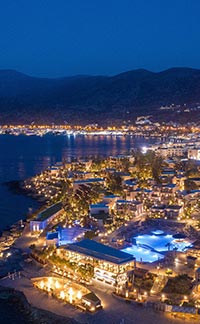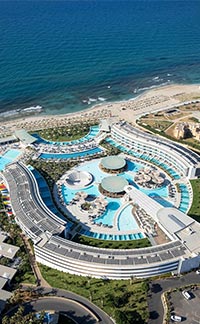The ruins of the Minoan villa at Agia Triada, near the central portion of the south coast of Crete, command the western end of a coastal ridge which looks down onto the Mesara Plain. The eastern end of this same ridge is anchored by ancient Phaistos, about 4 km away. The southern leg of the east-west Cretan National Road passes near both sites. Agia Triada is also about 10 km northeast of the coastal former hippie enclave of Matala.
More tablets with the Minoan Linear A script have been found in Agia Triada than any other archeological site on Crete. Linear A was the semi-pictographic writing used by the Minoans and has never been deciphered. (Its descendant, Linear B, was used by the later Mycenaeans and has been deciphered and is considered a forerunner of ancient Greek).
It is believed that the villa was summer residence for the king of Phaistos. Its name comes from the nearby village of Agia Triada (Holy Trinity), abandoned in 1897. Agia Triada was excavated at the same time Phaistos was, from 1900-1908, by the Italian Archeological School of Athens. In addition to the palatial villa, several inter-connected buildings of a small town have been uncovered. Other than the Linear A tablets, other notable finds at Agia Triada include the 15th century BC Harvester's Vase, which features carved images of winnowers with their sticks, accompanied by musicians.
The Agia Triada Sarcophagus
The14th century BC Agia Triada Sarcophagus (Heraklion Archeological Museum) was discovered in 1903. This 1.37 meter-long limestone container, which housed the remains of a local prince, was coated with plaster and then decorated, fresco-style, with colorful images and patterns. It is the oldest surviving European painting.
Experts are a bit puzzled by this object, since the Minoans only used frescoes as decorative elements in their homes, and not, as did the Egyptians, on funerary items. The explanation probably lies in the fact that the Minoans had strong trade relations with the Egyptians during this time period, which coincides with the 18th Dynasty of Egypt.. Some of the imagery in the fresco is Egyptian, such as a tree, which represents regeneration or resurrection in Egyptian cosmology. It's the only 14th century BC limestone sarcophagus found in this region. Sarcophagi found on the Aegean Islands dated later than this one were decorated with more abstract designs and patterns.
The frescos depict a Minoan death and afterlife worship ritual for an important personage. On one side a bull tied up with scarlet ropes on an altar is being sacrificed to the accompaniment of a double flute. Its blood drips into a bucket. A priestess blesses the sacrifice with libations in front of an alter surmounted by double-bladed axes, upon which perch two birds. Behind the alter is a sacred tree.
The other side shows, on the left, a woman wearing a crown and carrying two vessels. Preceding her is a man playing a lyre. This is the earliest depiction of such an instrument. To his right a woman empties the contents of one vessel into another. On the right side, a boat and live bulls held in the arms of 3 men are offered to a male- perhaps the deceased- who stands in front of a palace.
On one end of the sarcophagus there is a goddess riding in a griffin-drawn chariot, and on the other end is a chariot drawn by animals which are half-horse and half-goat.
Agia Triada was destroyed in 1450 BC, rebuilt, and remained occupied until the 2nd century, BC. Sometime after this a Roman villa was built on its site. The deserted village contains the small Agia Triada church.

